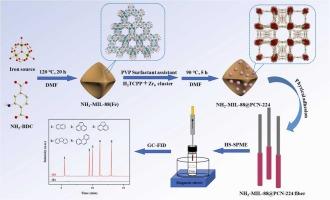通过表面活性剂辅助生长策略制备 MOF-on-MOF 复合材料,用于多环芳烃的 SPME
IF 11.3
1区 环境科学与生态学
Q1 ENGINEERING, ENVIRONMENTAL
引用次数: 0
摘要
多环芳烃(PAHs)是一类持久性有机污染物,具有很强的致癌性和致突变性,对环境和食物造成极大危害。本文通过表面活性剂辅助生长策略,在主NH2-MIL-88上原位生长客体PCN-224,制备了一种复合材料(NH2-MIL-88@PCN-224),并成功应用于牛奶样品中多环芳烃的固相微萃取(SPME)。所制备的 SPME 涂层具有多孔结构、超大比表面积、强 π-π 堆积、疏水相互作用和尺寸匹配效应,因此对 PAHs 具有很高的萃取和吸附能力。基于 NH2-MIL-88@PCN-224 涂层纤维的 SPME-GC-FID 方法具有线性范围宽(1-200 ng mL-1)、检出限低(0.003-0.020 ng mL-1)、回收率高(92.15-106.64%)和重现性好等显著优点。该研究采用表面活性剂辅助生长策略,克服了晶格匹配的限制,为制备萃取效率极高、热稳定性优异、使用寿命长的超高性能SPME涂层提供了新的方向,极大地丰富了MOF SPME涂层的种类。本文章由计算机程序翻译,如有差异,请以英文原文为准。

Fabrication of MOF-on-MOF composites by surfactant-assisted growth strategy for SPME of polycyclic aromatic hydrocarbons
Polycyclic aromatic hydrocarbons (PAHs) are a class of persistent organic pollutants with strong carcinogenicity and mutagenicity, which cause great harm to the environment and food. Herein, a composite (NH2-MIL-88@PCN-224) was prepared through a guest PCN-224 in situ grown on the host NH2-MIL-88 by a surfactant-assisted growth strategy, and successfully applied for solid-phase microextraction (SPME) of PAHs from milk samples. The prepared SPME coatings exhibited high extraction and adsorption capacity for PAHs due to their porous structure, ultra-large specific surface area, strong π-π stacking, hydrophobic interactions and size-matching effects. The SPME-GC-FID method based on NH2-MIL-88@PCN-224 coated fibers has the significant advantages of wide linear range (1–200 ng mL−1), low detection limit (0.003–0.020 ng mL−1), high recoveries (92.15–106.64 %) and good reproducibility. This work overcomes the lattice-matching limitation by adopting a surfactant-assisted growth strategy, which offers a new direction for the preparation of ultra-high-performance SPME coatings with extremely high extraction efficiency, exceptional thermal stability, and long service life, and greatly expands the variety of MOF SPME coatings.
求助全文
通过发布文献求助,成功后即可免费获取论文全文。
去求助
来源期刊

Journal of Hazardous Materials
工程技术-工程:环境
CiteScore
25.40
自引率
5.90%
发文量
3059
审稿时长
58 days
期刊介绍:
The Journal of Hazardous Materials serves as a global platform for promoting cutting-edge research in the field of Environmental Science and Engineering. Our publication features a wide range of articles, including full-length research papers, review articles, and perspectives, with the aim of enhancing our understanding of the dangers and risks associated with various materials concerning public health and the environment. It is important to note that the term "environmental contaminants" refers specifically to substances that pose hazardous effects through contamination, while excluding those that do not have such impacts on the environment or human health. Moreover, we emphasize the distinction between wastes and hazardous materials in order to provide further clarity on the scope of the journal. We have a keen interest in exploring specific compounds and microbial agents that have adverse effects on the environment.
 求助内容:
求助内容: 应助结果提醒方式:
应助结果提醒方式:


